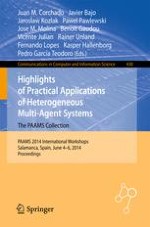This book constitutes the refereed proceedings of the workshops which complemented the 12th International Conference on Practical Applications of Agents and Multi-Agent Systems, PAAMS 2014, held in Salamanca, Spain, in June 2014. This volume presents the papers that have been accepted for the following workshops: Workshop on Agent-based Approaches for the Transportation Modeling and Optimization (AATMO 2014); Workshop on Agent-based Modeling and Simulation of Complex Systems: Engineering and Applications (ABSEA 2014); Workshop on Agents and Multi-Agent Systems for Ambient-assisted Living and e-Health (A-HEALTH 2014); Workshop on Agent-based Solutions for Manufacturing and Supply Chain (AMSC 2014); Workshop on Intelligent Systems for Context-based Information Fusion (ISCIF 2014); Workshop on Multi-Agent based Applications for Smart Grids and Sustainable Energy Systems (MASGES 2014); Workshop on Active Security Through Multi-Agent Systems (WASMAS 2014); Workshop on Intelligent Human-Agent Societies (WIHAS 2014).
